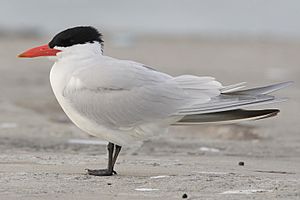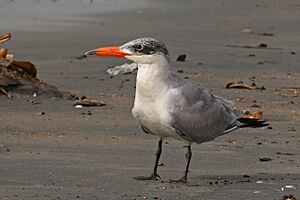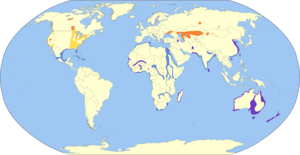Caspian tern facts for kids
Quick facts for kids Caspian tern |
|
|---|---|
 |
|
| Breeding Plumage Canada |
|
 |
|
| Non-breeding Plumage The Gambia |
|
| Conservation status | |
| Scientific classification | |
| Genus: |
Hydroprogne
|
| Species: |
caspia
|
 |
|
| Synonyms | |
|
Sterna caspia |
|
The Caspian tern (Hydroprogne caspia) is a large type of tern bird. You can find these birds in many parts of the world, but they are spread out. Even though they live in many places, they are the only species in their group (genus). This means there are no different kinds of Caspian terns. Their scientific name, Hydroprogne, comes from old Greek and Latin words meaning "water" and "swallow." The name caspia comes from Latin and points to the Caspian Sea, just like their English name.
Contents
About the Caspian Tern
What Do Caspian Terns Look Like?
The Caspian tern is the biggest tern in the world! It can be about 48–60 cm (19–24 in) long. Its wings can spread out to 127–145 cm (50–57 in) wide. These birds usually weigh between 530–782 g (18.7–27.6 oz).
Adult Caspian terns have black legs. They have a long, thick bill that is red-orange with a small black tip. Their head is white, but they have a black cap on top. Their neck, belly, and tail are also white. The top of their wings and back are light grey. The underside of their wings is light, with dark feathers at the tips.
When they fly, their tail is not as deeply forked as other terns. The tips of their wings look black from underneath. In winter, they still have their black cap, but it might have some white streaks. Their call sounds like a loud croak, similar to a heron.
Where Do Caspian Terns Live?
Caspian terns build their nests near large lakes and ocean coasts. You can find them in North America, including the Great Lakes. They also live in parts of Europe, especially near the Baltic Sea and Black Sea. Other homes include Asia, Africa, and Australasia (like Australia and New Zealand).
Birds from North America fly south for winter. They go to southern coasts, the West Indies, and northern South America. Terns from Europe and Asia spend their winters in warmer parts of the world. Birds in Africa and Australasia usually stay in the same area or move short distances.
Caspian Terns Moving North
In 2016, a Caspian tern nest was found in Cape Krusenstern National Monument in Alaska. This was 1,000 miles further north than they had ever been seen before! This shows a trend of many species moving north in Alaska. Scientists think this is happening because of global warming.
How Many Caspian Terns Are There?
There are about 50,000 pairs of Caspian terns around the world. In most places, their numbers are steady. However, the group living around the Baltic Sea is shrinking. This group had about 1,400 to 1,475 pairs in the early 1990s. Because of this, people are working to protect them.
The Caspian tern is also part of an important agreement. This agreement helps protect birds that fly long distances between Africa and Eurasia. It is called the Agreement on the Conservation of African-Eurasian Migratory Waterbirds (AEWA).
Caspian Tern Habits
How Do Caspian Terns Find Food?
Caspian terns mainly eat fish. They are great at fishing! They fly high above the water, then hover in place. After spotting a fish, they plunge headfirst into the water to catch it.
Sometimes, they also eat large insects. They might even eat the young or eggs of other birds. Small rodents are also on their menu sometimes. They can fly up to 60 km (37 mi) away from their nesting area to find fish. They often fish in freshwater lakes as well as in the sea.
How Do Caspian Terns Raise Their Young?
Caspian terns breed in spring and summer. The female usually lays one to three eggs. These eggs are pale blue-green with many brown spots.
They can nest together in large groups called colonies. Sometimes, they nest alone among other terns and gulls. Their nest is usually on the ground, made of gravel and sand. Sometimes, they use plants to build it. The parents take turns sitting on the eggs for 26 to 28 days.
The chicks (baby birds) can look very different from each other. Some are pale and creamy, while others are darker grey-brown. This helps the adult terns recognize their own chicks when they return to the colony after finding food. The young birds are ready to fly after 35 to 45 days.
Gallery







